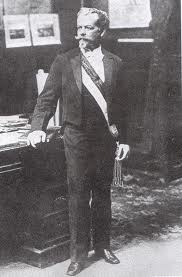Nicolás de Piérola
| Nicolás de Piérola | |
|---|---|
 | |
| "Supreme Commander-in-Chief" (War of the Pacific) | |
| In office December 12, 1879 – November 28, 1881 | |
| Preceded by | Mariano Ignacio Prado |
| Succeeded by | Francisco García Calderón |
| 28th President of Peru | |
| In office September 8, 1895 – September 8, 1899 | |
| Preceded by | Manuel Candamo |
| Succeeded by | Eduardo López de Romaña |
| Personal details | |
| Born | January 5, 1839 Arequipa, Peru |
| Died | June 23, 1913 (aged 74) Lima, Peru |
| Nationality | Peruvian |
| Political party | Democratic Party of Peru |
| Spouse(s) | Jesusa de Iturbide |
H.E. Don Jose Nicolás Baltasar Fernández de Piérola y Villena (known as "El Califa" ("The Caliph"); January 5, 1839 – June 23, 1913) was a prominentPeruvian politician, the Finance Minister and twicePresident of the Republic of Peru (from 1879 to 1881 and 1895 to 1899).
Contents[hide] |
[edit]Early years
Nicolás de Piérola was born and educated in the southern Peruvian city of Arequipa. He moved to Limato study theology at the Seminario de Santo Toribio, and later obtained his law degree from the Faculty of Law. His parents died in 1857.
He married Doña Jesusa de Iturbide, believed to be the illegitimate daughter of Agustin Jerónimo de Iturbide y Huarte the son of Emperor Agustín de Iturbide ofMexico.
[edit]Political life
[edit]Minister of Economy
From 1868 to 1871, he became Finance Minister under President José Balta. He requested, from the Parliament, broad powers in order to negotiate with several companies and to get the best possible deal. The result of his negotiations, the so-called "Hires Dreyfus" treaty was signed with aFrench company, the "Dreyfus Brothers".
The treaty granted the Dreyfus house of Paris the monopoly of the Peruvian guano exports. Though successful at first, he was later accused and impeached under Pardo's administration of misappropriating funds, but was honorably acquitted of dishonest practice after he managed to obtain the support of Congress.
[edit]Coup against Prado
On May 6, 1877, in an attempt to overthrow the government of Mariano Ignacio Prado the ironcladHuáscar was seized at Callao port by followers of de Pierola. Led by the retired Navy Captain German Astete, it took part in the inconclusive Battle of Pacocha in which, at the helm of the monitor "Huáscar", they defeated (some say the battle was a draw) two British ships, the "Amethyst" and the "Shah".
Huáscar, however, surrendered to the government after almost one month of sabotage actions. Piérola was taken to Callao after he surrendered, he preferred to remove himself to Valparaiso and later to Europe.
[edit]War of the Pacific
[edit]Coup against Prado
Piérola was finally allowed to come back to Peru in 1879, taking advantage of the War of the Pacific(1879–1883) with Chile. In the course of these deliberations, President Mariano Ignacio Prado left his vice president, Luis La Puerta in charge of the government and decided to leave for Europe to buy more armament and obtain more money for the war. Many Peruvians (and parts of the Armed Forces) took this as an excuse for his inability to govern in the middle of the war.
During the course of these events, Piérola took advantage of President Prado's absence and proclaimed himself "Supreme Commander in Chief" on December 21. With part of the Army supporting his actions, he launched a successful coup d'etat, with heavy fighting and casualties between both factions. Piérola assumed full power on December 23, 1879.
[edit]Supreme Commander-in-Chief
Piérola, after securing the loyalty of the troops that were in the capital, launched a ruthless campaign to censor the press. "El Comercio", the oldest newspaper in the capital, did not appear for 3 years. The Army was purged, and in several cases the seniority was ignored. Officers loyal to Pierola were put in charge based only in their political allegiance rather than experience. General.Andrés Avelino Cáceres and Admiral Lizardo Monteroviewed their influence severely diminished.
After several defeats that the Peruvian Army suffered inTacna and Arica, Piérola ordered what was left of the Army to protect the capital. In this way, the Peruvian army and poorly armed citizens that volunteered to the fight were set up to defend Lima. Fooled by the enemy, Piérola expected a Chilean assault from the north of the city, and marched with a large contingent of troops to the city of Ancón.
At the end, the Chilean assault was launched from the south. In this way, and with no reinforcements available, the Peruvian forces were defeated in the battles of San Juan andMiraflores, and the city of Lima fell in January 1881 to the forces of General Baquedano. The southern suburbs of Lima, including the upscale beach area of Chorrillos, were sacked and burned to the ground.
After Chilean forces invaded Lima in 1881, Piérola had to abandon the capital and leave forAyacucho, yet was unsuccessful commanding Peruvian forces from there also. To make matters worse, Chile had never recognized his government. Chile installed its own Government in Lima, and Piérola was soon forced to resign in the midst of the conflict on November 28 of that same year. What remained of his forces was gathered by Andrés Avelino Cáceres, who was able to launch a guerrilla war against the invading Chilean forces.

vaded Lima in 1881, Piérola had to abandon the capital and leave forAyacucho, yet was unsuccessful commanding Peruvian forces from there also. To make matters worse, Chile had never recognized his government. Chile installed its own Government in Lima, and Piérola was soon forced to resign in the midst of the conflict on November 28 of that same year. What r https://idheas.org/nicolas-de-pierola/
ResponderEliminar